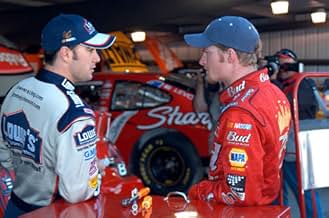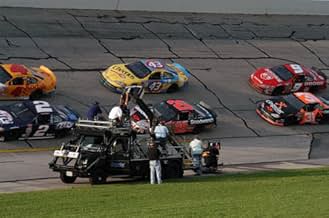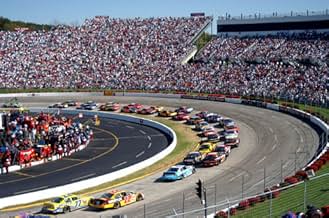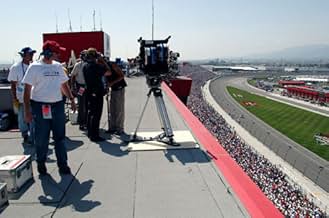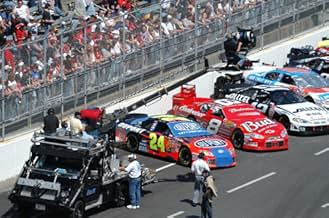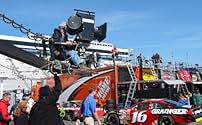AVALIAÇÃO DA IMDb
6,9/10
668
SUA AVALIAÇÃO
Adicionar um enredo no seu idiomaA big-screen look into one of America's most successful entertainment industries, NASCAR racing.A big-screen look into one of America's most successful entertainment industries, NASCAR racing.A big-screen look into one of America's most successful entertainment industries, NASCAR racing.
- Prêmios
- 1 vitória no total
Kiefer Sutherland
- Narrator
- (narração)
Bill France Jr.
- Bill France Sr.
- (narração)
Enredo
Você sabia?
- Versões alternativasIMAX theaters that were not capable of showing 3D movies showed "NASCAR: The IMAX Experience", an alternate 2D version.
- Trilhas sonorasJesus Built My Hotrod
Written by Michael Balch, Paul Barker, Gibby Haynes, Al Jourgensen (as Alien Jourgensen) and Bill Rieflin
Performed by Ministry
Courtesy of Sire Records
By Arrangement with Warner Strategic Marketing
Avaliação em destaque
VVVRRRRRrrroooommm! The thunderous sounds at a typical NASCAR race should be unforgettable for anybody that has seen a race on TV or live at the stadium.
The excitement of watching cars drive around at almost 200 mph is lost on some, but for some people it's become almost a religion.
NASCAR, an acronym for National Association of Stock Car Auto Racing, is the subject of the latest IMAX phenomenon, "NASCAR 3D: The IMAX Experience." However, the film seems to be made primarily for educating the general public.
Not that that's a bad thing. The film deals with all possible aspects of NASCAR racing, so even NASCAR enthusiasts might learn something. Director Simon Wincer, the man that brought us the "Lonesome Dove" miniseries, brings us a film that makes us almost all of us care about the sport, NASCAR fan or not.
The script, written by Sports Illustrated NASCAR correspondent Mark Bechtel, is typical documentary fare, with interviews, stock footage, and a lot of factual information.
The first half of the movie deals largely with the history of NASCAR. The movie opens with a dramatized chase through the North Carolina wilderness, thus setting up the evolution of the sport that would eventually become NASCAR.
Following the discussion of the 1947 conference that laid the foundations of NASCAR, the film goes on to talk about some of the (relatively) early NASCAR greats: Junior Johnson, Lee Petty, Richard Petty, Kyle Petty, Darrell Waltrip, and of course, Dale Earnhardt.
Yes, they do have footage from the 2001 race that killed NASCAR's greatest star. Though they don't actually show the crash, they do make reference to it. Anybody watching the film with a more-than-mild interest in NASCAR had better expect an emotional reaction. The crash serves as a bridge linking the first half to the second half: How NASCAR Works.
This film goes through everything you can think of, from the engineers in garages building car frames and engines to the pit crews training 38 out of the 52 weeks a year.
The film discusses the importance of teams, how a typical race works, and even what the fans are like. People that know nothing about NASCAR would learn a lot from this film.
Okay, so there¡¦s nothing really special about the script, but that's not where this film excels. "NASCAR 3D" makes the most of the IMAX technology, and the filmmakers know it. "NASCAR 3D" is one of the few IMAX movies that have the IMAX specs right on the poster.
The film's remarkable cinematography puts you right into the action. Cars zoom past camera placed on the track. Cameras inside the car allow you to see what the driver sees. Aerial shots show exactly what a mob of 120,000 people looks like. The list goes on.
The editing job is top notch. Rapid editing gives viewers the impression that there is a lot more going on in the race than cars racing around a racecourse. An impressive sequence where stock footage of a crash is repeated all over the screen can best be described as awe-inspiring.
The IMAX sound technology is put to good use. The sound of roaring engines is strong enough to rumble the seats. Good luck in finding that same effect in movie theaters.
However, there is a surprisingly large amount of relatively quiet moments present in the film, so the rumble effect isn't used that often. This isn't actually that bad. After all, there is probably a limit to how much a person can stand to be vibrated.
The technological strengths of this movie make up for the blandness of the screenplay, making "NASCAR 3D" one of those rare documentaries that can keep viewers interested the whole way through.
If you're already a NASCAR fan, then "NASCAR 3D" is probably near the top on your must-see list. Well, I'm not so sure about what everybody had expected, but I suppose it's safe to say that it lives up to everybody expectations. If you're not a NASCAR fan, then "NASCAR 3D" is still a worthy piece of entertainment.
So "NASCAR 3D" is must-see material. The problem is finding a theater that plays it, as there are only 75 IMAX theaters in North America carrying "NASCAR 3D".
The excitement of watching cars drive around at almost 200 mph is lost on some, but for some people it's become almost a religion.
NASCAR, an acronym for National Association of Stock Car Auto Racing, is the subject of the latest IMAX phenomenon, "NASCAR 3D: The IMAX Experience." However, the film seems to be made primarily for educating the general public.
Not that that's a bad thing. The film deals with all possible aspects of NASCAR racing, so even NASCAR enthusiasts might learn something. Director Simon Wincer, the man that brought us the "Lonesome Dove" miniseries, brings us a film that makes us almost all of us care about the sport, NASCAR fan or not.
The script, written by Sports Illustrated NASCAR correspondent Mark Bechtel, is typical documentary fare, with interviews, stock footage, and a lot of factual information.
The first half of the movie deals largely with the history of NASCAR. The movie opens with a dramatized chase through the North Carolina wilderness, thus setting up the evolution of the sport that would eventually become NASCAR.
Following the discussion of the 1947 conference that laid the foundations of NASCAR, the film goes on to talk about some of the (relatively) early NASCAR greats: Junior Johnson, Lee Petty, Richard Petty, Kyle Petty, Darrell Waltrip, and of course, Dale Earnhardt.
Yes, they do have footage from the 2001 race that killed NASCAR's greatest star. Though they don't actually show the crash, they do make reference to it. Anybody watching the film with a more-than-mild interest in NASCAR had better expect an emotional reaction. The crash serves as a bridge linking the first half to the second half: How NASCAR Works.
This film goes through everything you can think of, from the engineers in garages building car frames and engines to the pit crews training 38 out of the 52 weeks a year.
The film discusses the importance of teams, how a typical race works, and even what the fans are like. People that know nothing about NASCAR would learn a lot from this film.
Okay, so there¡¦s nothing really special about the script, but that's not where this film excels. "NASCAR 3D" makes the most of the IMAX technology, and the filmmakers know it. "NASCAR 3D" is one of the few IMAX movies that have the IMAX specs right on the poster.
The film's remarkable cinematography puts you right into the action. Cars zoom past camera placed on the track. Cameras inside the car allow you to see what the driver sees. Aerial shots show exactly what a mob of 120,000 people looks like. The list goes on.
The editing job is top notch. Rapid editing gives viewers the impression that there is a lot more going on in the race than cars racing around a racecourse. An impressive sequence where stock footage of a crash is repeated all over the screen can best be described as awe-inspiring.
The IMAX sound technology is put to good use. The sound of roaring engines is strong enough to rumble the seats. Good luck in finding that same effect in movie theaters.
However, there is a surprisingly large amount of relatively quiet moments present in the film, so the rumble effect isn't used that often. This isn't actually that bad. After all, there is probably a limit to how much a person can stand to be vibrated.
The technological strengths of this movie make up for the blandness of the screenplay, making "NASCAR 3D" one of those rare documentaries that can keep viewers interested the whole way through.
If you're already a NASCAR fan, then "NASCAR 3D" is probably near the top on your must-see list. Well, I'm not so sure about what everybody had expected, but I suppose it's safe to say that it lives up to everybody expectations. If you're not a NASCAR fan, then "NASCAR 3D" is still a worthy piece of entertainment.
So "NASCAR 3D" is must-see material. The problem is finding a theater that plays it, as there are only 75 IMAX theaters in North America carrying "NASCAR 3D".
- ajnrules
- 13 de mar. de 2004
- Link permanente
Principais escolhas
Faça login para avaliar e ver a lista de recomendações personalizadas
Detalhes
- Data de lançamento
- Países de origem
- Central de atendimento oficial
- Idioma
- Também conhecido como
- NASCAR: The IMAX Experience
- Locações de filme
- Empresas de produção
- Consulte mais créditos da empresa na IMDbPro
Bilheteria
- Faturamento bruto nos EUA e Canadá
- US$ 21.583.831
- Fim de semana de estreia nos EUA e Canadá
- US$ 1.452.639
- 14 de mar. de 2004
- Faturamento bruto mundial
- US$ 22.248.831
- Tempo de duração48 minutos
- Cor
- Mixagem de som
- Proporção
- 1.44 : 1
Contribua para esta página
Sugerir uma alteração ou adicionar conteúdo ausente

Principal brecha
By what name was NASCAR: A Experiência em IMAX (2004) officially released in Canada in English?
Responda



